Emi Setura Linga ~ by Sri. Bala Murali Krishna
Emi Setura Linga ~ by Sri. Bala Murali Krishna
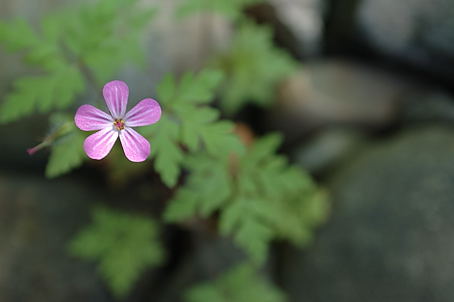
Your passionate response to the “FAHC-Subscribe to Smiles fund-drive” is clearly indicative that all of us are determined to make a positive difference in the world. By being calmly active and actively calm, the encouragement, confidence and support you showed is heartwarming. It is truly an honor to receive such a response. I believe that we are helping ourselves, for a better tomorrow, by helping our future generations.
My thanks to the fellow bloggers and friends, who believed in this effort and readily donated time and offered amazing prizes:
Vijay K Narayanan, Anjali, Bee&Jai, Manisha, Padmaja, Shilpa, Mythili, Siri, Richa, Madhuli and Maria.
Special thanks to author and chef Suvir Saran and to Shruthi Reddy for their compassion, generous contribution and prize offers. It is a blessing to have such kind-hearted friends. I am also grateful to all who have written about this event and spread the word.
I sincerely thank all individual donors on behalf of fundraising team for the contributions. You are the people who made the goal accomplished. Your encouragement gave the FAHC team a great positive push to keep working continuously towards this mission. Thank you again for your generosity, which will make it possible for many children to have a quality life. You can find more details about the FAHC campaign, and the benefiting children at feedahungrychild.org.
For raffle-draw, I had taken the help of my friend’s daughter, three year old Manasa, to randomly pick the winners. For each prize, we have written down all the names and placed the folded paper slips in a jar. A vigorous shake and a pick. One prize at a time, the raffle-draw turned out to be a pleasant affair, all thanks to little cutie pie Manasa.
From Manasa’s hands, here are the raffle results:
| Prize |
Went to |
|---|---|
| 1. Grains, Greens, and Grated Coconuts (14 raffle tickets) |
Kala Narayan |
| 2. Supreme Spice Gift Box (11 raffle tickets) |
Priya Ramamurthy |
| 3. Complete Digital Photography (Two copies) (10 raffle tickets) |
Krithika Sukumaran Padmaja Kochera |
| 4. American Masala (Two Copies) (15 raffle tickets) |
Linda Shruthi Reddy |
| 5. Indian Home Cooking (Two Copies) (8 raffle tickets) |
A B Archana Bhat |
| 6. Dinner for two at Devi (Two Prizes) (1 raffle ticket) |
Suganthi |
| 7. Children’s Saree Dress (Two Prizes) (2 raffle tickets) |
Megha Abburu Deepika Gadiparthi |
| 8. Fair-trade Goodies Bag (Two Prizes) (4 raffle tickets) |
Swati Thorat Ashwini of Food for Thought |
| 9. Mountain Valley~ Oil on Canvas (7 raffle tickets) |
Chandrarekha |
| 10. Ceramic Vindu Plate (4 raffle tickets) |
Vasantha Vemula (Rohini) |
| 11. 30-Minute Meals (1 raffle ticket) |
Chandana Pandrangi |
| 12. Dark Chocolate Made with Icewine (3 raffle tickets) |
Lee and Friends |
| 13. Cooking at Home with Pedatha (12 raffle tickets) |
M M |
| 14. Dakshin (2 raffle tickets) |
Gururajan |
| 15. Essential Andhra Cookbook (7 raffle tickets) |
Dee and K |
| 16. World Vegetarian (4 raffle tickets) |
Ranjini Rajeevan |
| 17. Madhur Jaffrey’s Indian Cooking (1 raffle ticket) |
Spandana and Jagadish |
| 18. The Red Chilli (1 raffle ticket) |
Sreelu of Tasty Travels |
All the winners will be notified via Email. The winners have to provide and confirm their shipping addresses. The prize sponsors will then send the gifts directly to the winners. Please allow 2 to 3 weeks for the prizes to reach you. Thank you.
Questions, concerns? Please contact me at donatesmiles@gmail.com.

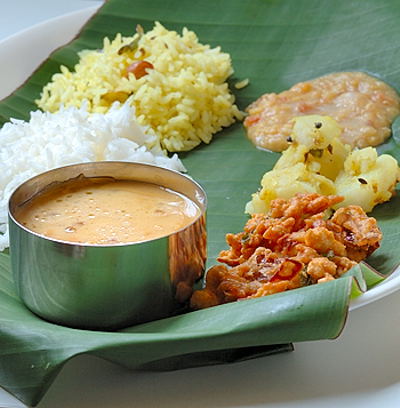
In many countries, particularly in rural areas, the people’s resources are very less and so are their needs. The lack of resources and parents’ inability to earn money always affects the little ones in the family. Due to this, children do not get food to eat, do not have proper education or are forced to go to work at a very young age. What I have also noticed is, a very little amount of money could bring a tremendous change in a child’s and in a family’s life. For example, the money we’d usually spend on one meal in a restaurant (about US$25) could feed an entire family for several days in India. Not having a meal in a restaurant will not make any difference in our lives, but having proper food for several days in a month would definitely bring great change in a family in need.
We all might have recognized this fact and have thought about it at some point of time, but we could not do anything directly. Individually we would not be able bring a sustainable change, but collectively we could. This is what exactly FAHC is trying to do – mobilizing similarly thinking people to contribute small amounts of money and make it use where it is greatly needed. What greater cause is there in this world than giving proper food, clothing and reading materials to a needy child?

FAHC is a non-profit organization. Started by Vijay K Narayanan, a fellow food blogger from India. Here is how FAHC is making a difference:
“FAHC began its pilot operation of feeding program on April 17, 2007, at Palakkad district of Kerala in India. The event was a full-day affair involving all the FAHC-supported children, their caretakers, and a few well-wishers from the neighborhood. We gathered at the chairperson’s house where we organized a lunch with children followed by the distribution of the first monthly feeding kits and gifts. The program was implemented correctly for well-identified 10 families to support a total of 14 children in the pilot feeding project. Our visits to their houses were so inspiring; at times we literally had tears in our eyes seeing their tragic living conditions. They have very meager support systems and have no fathers. Some of them do not have both parents. The children face so many hurdles that it becomes even more important to lend them a helping hand early in life. Now they have a hope. FAHC is aiming to make a tangible difference in the lives of these chosen children.
FAHC will provide support to the children and their families by providing better food via feeding kits, education, healthcare, and welfare.
Educationally, FAHC will henceforth take care of the costs of their textbooks, notebooks, school bag, umbrella, uniforms, school fees, tuition fees, etc. We will also conduct study classes, camps, and games during vacation holidays for the children.”
To generate funds for this effort, FAHC has set forth a modest goal of raising 3,360 dollars. I am keen on this cause and together with fellow food bloggers, we have come up with few exciting prizes for a raffle fundraiser. I thank Anjali, Bee and Jai, and Suvir Saran for their support, effort and contributions.
The following prizes make great gifts, and each item will be sent to the raffle winner neatly packed and shipping expenses paid.
I strongly believe that the money we generate through this raffle fund-raising goes towards feeding at least few hungry mouths. Please see if you would be able to contribute by bidding on the items of your choice. Thank you!
1. Grains, Greens and Grated Coconuts ~ by Ammini Ramachandran
(from Me)
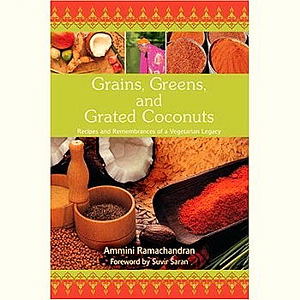
“Grains, Greens, and Grated Coconuts is more than a cookbook-it is a collection of treasured memories and delicious family recipes presented against a backdrop of Indian culinary and cultural history. Familiar with Western cooking methods, Ramachandran shows how to integrate these recipes into a Western-style menu and suggests ways for home cooks to expand their repertoire without having to create an entire menu of dishes.”
Ammini Ramachandran’s website: Peppertrail.com
Reviews at Amazon.com
2. A Gift Box of Spice Extracts
(From Anjali Damerla of Supreme Spice)
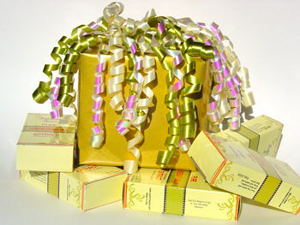
Cardamom, Ginger, Kesar Milk masala, Tea Masala and Tulsi spice.
3. Complete Digital Photography ~ by Ben Long .
From Bee and Jai of Jugalbandi. (Two copies. Raffle winners get one copy each.)

“Complete Digital Photography has become a classic book for helping traditional photographers move to digital! It’s also the book of choice for many new digital photographers who want to learn how to take great digital photos. Now in its 4th edition, this bestseller has been fine-tuned and updated to provide the most current information available.”
Reviews at: Amazon.com
4. American Masala ~ by Suvir Saran
Autographed and shipped directly by the acclaimed chef and author Sri. Suvir Saran. (Two copies. Raffle winners will get one copy each.)
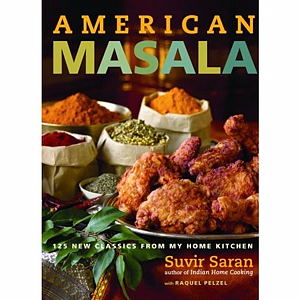
5. Indian Home Cooking ~ by Suvir Saran
Autographed and shipped directly by chef and author Sri. Suvir Saran.
(Two copies. Raffle winners will get one copy each.)
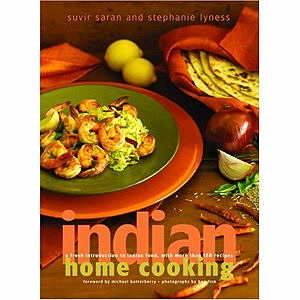
6. Dinner for Two, at Elegant “Dévi” Restaurant, New York City
Two Prizes and wine included. Generously contributed by owner and chef Sri. Suvir Saran.


(You can find detailed information about raffle prizes 3 to 6 at Jugalbandi.)
7. Two ready-to-wear children’s sarees with matching blouses
From Manisha of Indian Food Rocks
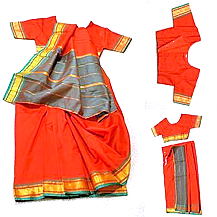
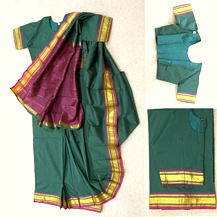
8. Two Fair-Trade Goodies Bags from UK
From Padmaja of Spicy Andhra
Raffle winner will get a gift bag each.
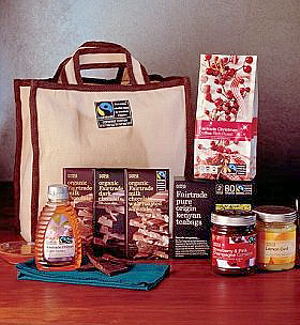
Goodies Bag contains Fairtrade Products:
Christmas Rich Roast Coffee, Pure Origin Kenyan Teabags (80 teabags), Lemon Curd, Strawberry and Pink Champagne Conserve, Chilean Clear Honey, Organic Milk Chocolate Bar, Organic Dark Chocolate Bar, Organic Milk Chocolate With Roasted Almonds Bar
Details and photos at Spicy Andhra.
9. Mountain Valley – Oil on Canvas Painting (16 X 20)
From Shilpa of Aayi’s Recipes

10. A Personalized Ceramic “Vindu” Plate
From Mythili of Vindu
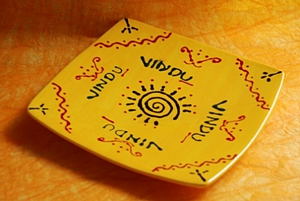
11. 30-Minute Meals ~ by Rachel Ray
From Siri of Siri’s Corner
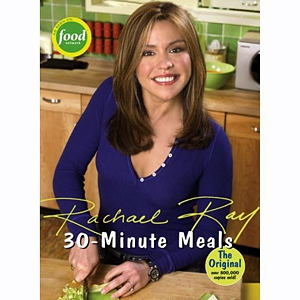
12. Dark Chocolate Made With Icewine
From Richa of As Dear As Salt
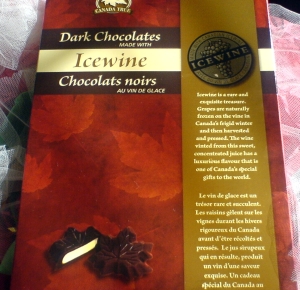
Rare kind of chocolate in which grapes are naturally frozen on the vine in Canada’s frigid winters and then harvested and pressed. The wine from the juice adds a luxurious flavor and this dark chocolate is a speciality from Canada.
Details and Photos at As Dear As Salt.
13. Cooking at Home with Pedatha by Jigyasa Giri, Pratibha Jain
From Shruthi, a Friend of Mahanandi
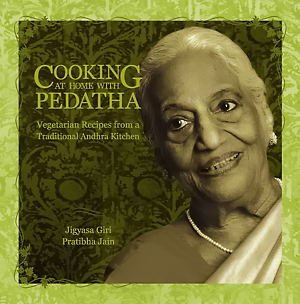
“Rendered in stunning aesthetics, here is a traditional fare from Andhra Pradesh, the rice-bowl of India which boasts of one of the sweetest of languages and spiciest of foods. Fluffy, steaming rice with spicy chutneys, piquant powders, wholesome dals and mouth-watering vegetables. In easy-to-do-steps, learn these traditional vegetarian recipes as taught by an 85-year-young grandmother.”
Authors website: http://www.pritya.com/index.html
Reviews at: Amazon.com
14. Dakshin: Vegetarian Cuisine from South India by Chandra Padmanabhan
From Shruthi, a Friend of Mahanandi
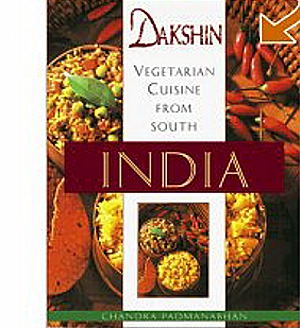
“Dakshin” is an ancient Sanskrit word meaning “south.” It symbolizes what this Cookingbook is all about – the best and most delicious of South Indian vegetarian cuisine. Filled with tempting recipes and evocative photographs, Dakshin takes you through the elements of South Indian meals, including chutneys and pickles, rice dishes, pakoras, payasams, poriyals, kootus, bondas, and vadais. With its use of fresh produce and a Healthy, balanced approach to eating, Dakshin is an ideal Cookingbook for today’s lifestyle.”
Reviews at: Amazon
15. Essential Andhra Cookbook with Hyderbadi & Telangana Specialities ~ by Latif I Bilkees
From Shruthi, a Friend of Mahanandi
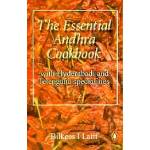
This book includes more than 200 recipes from Andhra, one of India’s largest and culturally most diverse state. Along with the recipes the author recounts the traditions and rituals associated with food such as the right order in which to serve the dishes. While Hyderabadi cuisine with its distinctive Mughlai flavor is famous around the world, food from the other parts of Andhra, one of India’s largest and culturally most diverse states, remains relatively unknown. In this edition, the author brings together for the first time the different tastes of Andhra cooking from the humble Idli-sambhar to spicy seafood delicacies.
16. Madhur Jaffrey’s World Vegetarian
From Shruthi, a Friend of Mahanandi
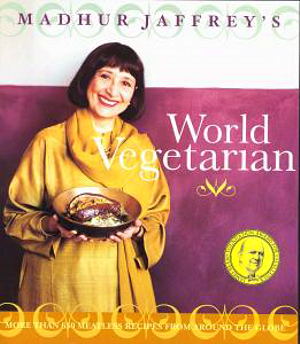
“In her most comprehensive volume yet, Madhur Jaffrey draws on more than four decades of culinary adventures, travels, and experimentation for a diverse collection that both intrigues and delights the palate. Dishes from five continents touch on virtually all the world’s best loved flavors, for a unsurpassed selection of vegetarian fare. More than 650 recipes exemplify Madhur’s unsurpassed ability to create simple, flavorful homecooking that is well within the reach of every cook.”
Reviews at: Amazon
17. Indian Cooking ~ by Madhur Jaffrey
From Maria, a Foodie + Techie Friend
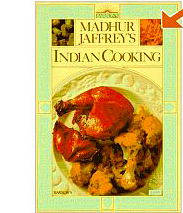
“One of the world’s foremost authorities on Indian cooking presents more than 100 authentic yet surprisinghly simple recipes for the best-loved delicacies of India. There are helpful chapters on equipment, techniques, seasonings, and menu planning as well. Color photographs.”
Reviews at Amazon.com
18. One Year Subscription to “The Red Chilli”
at www.sanjeevkapoor.com
From Madhuli of My Food Court
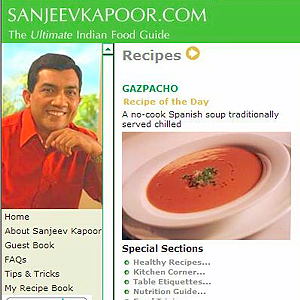
With “The Red Chilli” online food magazine subscription, you can access more than 1000 recipes, besides many other sections at beloved celebrity chef Sanjeev Kapoor’s website. A culinary treat to any food lover.
Details at My Food Court
How to Contribute:
Click on Chip-in. (It takes few seconds to load.)
Contribute: Via Paypal or credit. You can donate any amount. Each $25 donation will give you one raffle ticket towards a prize of your choice.
After you donate, please forward your payment confirmation message to donatesmiles@gmail.com, clearly specifying which prize you are interested in. Do mention how many tickets per prize, for example, a donation of $50 will buy you 2 raffle tickets for a cookbook.
For all correspondence by email, please use the same email address that you have used for your Chip-in contribution. This helps us validate your entry to the raffle and to contact you should you win a prize.
The event will close on 23rd October and raffle prize winners will be announced on 25th here at Mahanandi and at respective blogs. (The drawing will be done manually).
If you need more information about the prizes, please contact me using the comments form below or mail me at donatesmiles@gmail.com.
Cynicism may be cool, but compassion always rocks. Make a rocking choice!
Thank you.
| Name | Contribution | Raffle |
|---|---|---|
| Singari Vijay | $ 25 | Supreme Spice Gift Box |
| Srivalli Jetti | $ 25 | Indian Home Cooking |
| Linda | $ 25 | American Masala |
| Manisha Pandit | $ 25 | American Masala |
| Shilpa | $ 25 | Complete Digital Photography |
| Padmaja Kochera | $ 25 | Complete Digital Photography |
| Sharmi Komali | $ 25 | Grains, Greens and Grated Coconuts |
| Siri at Siri’s Corner | $ 25 | Cooking at Home with Pedatha |
| Mythili & N of Vindu | $ 50 | 2 for Grains, Greens and Grated Coconuts |
| Ashwini Gopinath | $ 25 | Supreme Spice Gift Box |
| Madhuri Annam | $ 25 | Ceramic “Vindu” Plate |
| Shruthi Reddy | $ 1,000 | 5 for American Masala 5 for Indian Home Cooking |
| Sunita Bhuyan | $ 25 | Complete Digital Photography |
| Swarna Turaka | $ 25 | Supreme Spice Gift Box |
| Ashwini of Food for Thought | $ 101 | 2 for Fair-Trade Goodies Bag 2 for Grains, Greens and Grated Coconuts |
| Mandira of Ahaar | $ 25 | Supreme Spice Gift Box |
| Anitha Medichetti | $ 50 | |
| Jyostana Bhatt | $ 20 | |
| Sangeeta Dhawan | $ 100 | |
| Vijayakumar Narayanan | $ 50 | |
| Sridhar Kudaravalli | $ 15 | |
| Archana Bhat | $ 30 | Indian Home Cooking |
| Manikandan Subramanian | $ 101 | |
| Madhavi Kadaba (Madhu’s Vantalu) |
$ 30 | Essential Andhra Cookbook |
| Anonymous(per request) | $ 25 | |
| John Darnielle | $ 30 | |
| Sigma Sreedharan | $ 25 | American Masala |
| Madhuli(My Food Court) | $ 50 | 1 for Complete Digital Photography 1 for Mountain Valley |
| Indhu Balasubramaniam | $ 25 | |
| Roopa Anantharamu | $ 10 | |
| Amanda Waddell | $ 25 | |
| Laavanya Dheenadayalan | $ 30 | Supreme Spice Gift Box |
| Priya Ramamurthy | $ 25 | Supreme Spice Gift Box |
| Balaji Srinivasan | $ 100 | |
| Ramya Panchangam | $ 25 | |
|
Happy Birthday Megha Abburu! (Snackorama) |
$ 50 | 1 for Children’s Saree Dress 1 for Complete Digital Photography |
| Sowmya | $ 25 | Grains, Greens and Grated Coconuts |
| Aarthi Thoppae | $ 25 | Mountain Valley, Oil on Canvas |
| Sasi Bannuru | $ 10 | |
| Chandrarekha | $ 75 | 2 for Mountain Valley 1 for Ceramic Plate with “VUYYURUS” written on it |
| Rajitha(Hunger Pangs) | $ 25 | Grains, Greens and Grated Coconuts |
| Mohtashim Shaikh | $ 25 | |
| Vasantha Vemula (Rohini) |
$ 50 | 1 for Supreme Spice Gift Box 1 for Ceramic Plate with “Vemulavari Vindu” written on it |
| Sonal Tailor | $ 25 | Grains, Greens and Grated Coconuts |
| Chandana Pandrangi | $ 25 | 30-Minute Meals |
| Sia & Krish (Monsoon Spice) |
$ 25 | Cooking at Home with Pedatha |
| Ranjini Rajeevan | $ 25 | World Vegetarian |
| Kavitha Guruswamy | $ 50 | 1 for Complete Digital Photography 1 for Mountain Valley |
| Krithika Sukumaran | $ 50 | 2 for Complete Digital Photography |
| Radhika Bhandarkar | $ 50 | 2 for G, G and Grated Coconuts |
| Kala Narayan | $ 50 | 1 for G, G and Grated Coconuts 1 for Cooking at Home with Pedatha |
| Sarvani K Akkanapragada | $ 25 | Cooking at Home with Pedatha |
| Dee and K | $ 50 | 2 for Essential Andhra Cookbook |
| Suneetha Yerneni | $ 25 | |
| Madhuri | $ 25 | Essential Andhra Cookbook |
| Shobana | $ 25 | Ceramic Vindu Plate |
| Madhavi Penmetcha | $ 25 | Complete Digital Photography |
| Sreelu of Sreelus Tasty Travels | $ 50 | 1 for G, G and Grated Coconuts 1 for The Red Chilli |
| Karuna | $ 20 | Supreme Spice Gift Box |
| Hemantkumar Naik | $ 25 | Cooking at Home with Pedatha |
| A B | $ 51 | 1 for Indian Home Cooking 1 for American Masala |
| Spandana&Jagadish (Cinnamon Trail) |
$ 50 | 1 for Madhur’s Indian Cooking 1 for Cooking at Home with Pedatha |
| Deepa Gumpeni | $ 25 | Icewine Dark Chocolate |
| Bhargavi Karri Thank you my friend! |
$ 25 | Mountain Valley |
| Gururajan | $ 50 | 1 for Dakshin 1 for Supreme Spice Gift Box |
| Sujatha Narayan | $ 25 | Supreme Spice Gift Box |
| Yeggi Easwaran | $ 25 | Grains, Greens and Grated Coconuts |
| Anjali Damerla | $ 25 | Icewine Dark Chocolate |
| Mitesh Damana | $ 20 | |
| Srivats Hariharan | $ 35 | |
| Lisa Johnson | $ 10 | |
| Akhila Rajan | $ 25 | |
| Suyog Kulkarni | $ 11 | |
| Madhu | $ 25 | World Vegetarian |
| Rachna Madhavan (Soul Food) |
$ 25 | Complete Digital Photography |
| Sandeepa (Bong Mom’s Cookbook) |
$ 15 | |
| Amaravathy | $ 25 | Mountain Valley |
| Suganthi | $ 25 | Dinner at Devi Restaurant |
| Swapna and Prasad | $ 15 | |
| Seema Vasagiri | $ 25 | Cooking at home with Pedatha |
| Lee and Friends | $ 75 | 2 for American Masala 1 for Icewine Dark Chocolate |
| Shoba Prabhakaran | $ 25 | Essential Andhra Cookbook |
| Anu Chandrasekhar | $ 11 | |
| Priya Sivaraman | $ 25 | American Masala |
| Charu Menon | $ 25 | American Masala |
| Asha Arvind (Foodie’s Hope) |
$ 30 | |
| T D | $ 25 | Cooking at Home with Pedatha |
| Deepika Gadiparthi | $ 25 | Children’s Saree Dress |
| Sudhir Padmaja | $ 50 | Cooking at Home with Pedatha |
| Mini Narayanan | $ 25 | Dakshin |
| Shub | $ 30 | Supreme Spice Gift Box |
| Sunanda Gudi | $ 25 | Essential Andhra Cookbook |
| Aditya | $ 50 | 2 for American Masala |
| Vijay Jayabalan | $ 25 | Essential Andhra Cookbook |
| Swati Thorat | $ 25 | Fairtrade Goodies Bag |
| M M | $ 180 | 3 for Cooking at Home with Pedatha -2 for World Vegetarian -1 for G, G and Grated Coconuts -1 for the Fairtrade Goodies Bag |
| PK Mohan | $ 30 | |
| Madhu Kolla | $ 10 | |
| Nalini Tamanna | $ 10 | |
| Veera Mylapore | $ 15 | |
| Pratibha Bhagwat | $ 15 | |
| Kavitha Mangalagiri | $ 180 | |
| V K | $ 25 | |
| Menu Today | $ 50 | |
| Senthil | $ 10 | |
| Venugopal Rao | $ 10 | |
| Mrugesh Desai | $ 25 | |
| Aruna Gollamudi | $ 25 | |
| Ulle Koolmar | $ 50 | |
| Donors to Date = 109 | $ 4,735 | Thank you! Raffle Results on Oct 25 |
Thanks to your generous contributions and goodwill shown towards “FAHC-Subscribe to Smiles”, we have reached the fund-drive goal of raising 3,360 dollars in a short time. Great achievement I must say. My sincere thanks to all the contributors!
This event will continue until Oct 23, 2007. All funds received from now on are bonus achievements for the “Feedahungrychild.org (FAHC)”. Thanks again for your generous support!
Note:
For full financial details about this fund-raising, please visit “Feedahungrychild.org (FAHC)” after October 23rd.
Thank you for your support! The “FAHC-Subscribe to Smiles” Raffle Fund-Raising has successfully concluded. Raffle results will be announced on Thursday, October 25th.

Your passionate response to the “FAHC-Subscribe to Smiles fund-drive” is clearly indicative that all of us are determined to make a positive difference in the world. By being calmly active and actively calm, the encouragement, confidence and support you showed is heartwarming. It is truly an honor to receive such a response. I believe that we are helping ourselves, for a better tomorrow, by helping our future generations.
My thanks to the fellow bloggers and friends, who believed in this effort and readily donated time and offered amazing prizes:
Vijay K Narayanan, Anjali, Bee&Jai, Manisha, Padmaja, Shilpa, Mythili, Siri, Richa, Madhuli and Maria.
Special thanks to author and chef Suvir Saran and to Shruthi Reddy for their compassion, generous contribution and prize offers. It is a blessing to have such kind-hearted friends. I am also grateful to all who have written about this event and spread the word.
I sincerely thank all individual donors on behalf of fundraising team for their contributions. You are the people who made the goal accomplished. Your encouragement gave the FAHC team a great positive push to keep working continuously towards this mission. Thank you again for your generosity, which will make it possible for many children to have a quality life. You can find more details about the FAHC campaign, and the benefiting children at feedahungrychild.org.
For raffle-draw, I had taken the help of my friend’s daughter, three year old Manasa, to randomly pick the winners. For each prize, we have written down all the names and placed the folded paper slips in a jar. A vigorous shake and a pick. One prize at a time, the raffle-draw turned out to be a pleasant affair, all thanks to little cutie pie Manasa.
From Manasa’s hands, here are the raffle results:
| Prize |
Went to |
|---|---|
| 1. Grains, Greens, and Grated Coconuts (14 raffle tickets) |
Kala Narayan |
| 2. Supreme Spice Gift Box (11 raffle tickets) |
Priya Ramamurthy |
| 3. Complete Digital Photography (Two copies) (10 raffle tickets) |
Krithika Sukumaran Padmaja Kochera |
| 4. American Masala (Two Copies) (15 raffle tickets) |
Linda Shruthi Reddy |
| 5. Indian Home Cooking (Two Copies) (8 raffle tickets) |
A B Archana Bhat |
| 6. Dinner for two at Devi (Two Prizes) (1 raffle ticket) |
Suganthi |
| 7. Children’s Saree Dress (Two Prizes) (2 raffle tickets) |
Megha Abburu Deepika Gadiparthi |
| 8. Fair-trade Goodies Bag (Two Prizes) (4 raffle tickets) |
Swati Thorat Ashwini of Food for Thought |
| 9. Mountain Valley~ Oil on Canvas (7 raffle tickets) |
Chandrarekha |
| 10. Ceramic Vindu Plate (4 raffle tickets) |
Vasantha Vemula (Rohini) |
| 11. 30-Minute Meals (1 raffle ticket) |
Chandana Pandrangi |
| 12. Dark Chocolate Made with Icewine (3 raffle tickets) |
Lee and Friends |
| 13. Cooking at Home with Pedatha (12 raffle tickets) |
M M |
| 14. Dakshin (2 raffle tickets) |
Gururajan |
| 15. Essential Andhra Cookbook (7 raffle tickets) |
Dee and K |
| 16. World Vegetarian (4 raffle tickets) |
Ranjini Rajeevan |
| 17. Madhur Jaffrey’s Indian Cooking (1 raffle ticket) |
Spandana and Jagadish |
| 18. The Red Chilli (1 raffle ticket) |
Sreelu of Tasty Travels |
All the winners will be notified via Email. The winners have to provide and confirm their shipping addresses. The prize sponsors will then send the gifts directly to the winners. Please allow 2 to 3 weeks for the prizes to reach you. Thank you.
This is an update on FAHC fundraising conducted last October.
The money raised through the fund-drive on Mahanandi went directly to the parent organization, VK Narayanan’s (VKN) – “Feed A Hungry Child organization (FAHC)”.
During November 07, VKN emailed us enquiring about opening a new FAHC chapter, I replied with details about our Nandyala school and the work we are doing. My husband, Vijay who manages the school also showed interest. VKN and Vijay started talking. We also consulted our father-in-law who is a trustee of the Nandyala school. This is what happened next.
My father-in-law, Sri Venkata Subbaiah traveled to Kerala on November 16th, 07 to meet and see the good work FAHC doing. From Nandyala, he went to Palakkad and from there to Pattenchery village, FAHC location and VKN’s ancestral home.
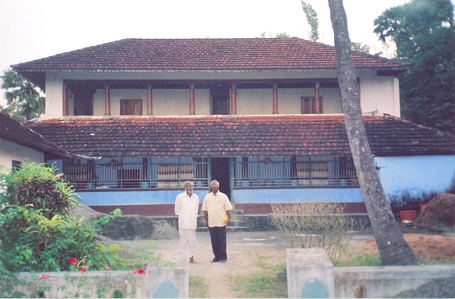
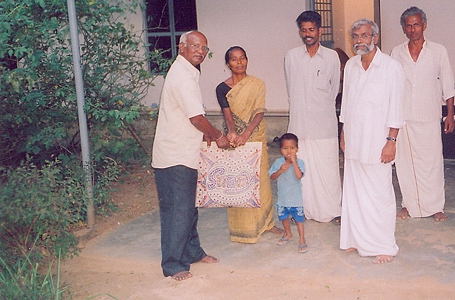
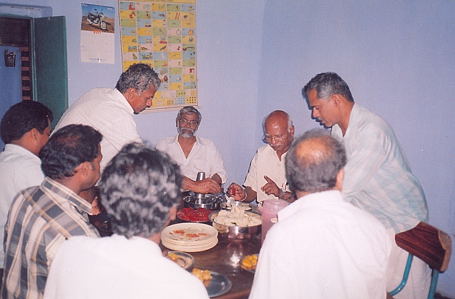
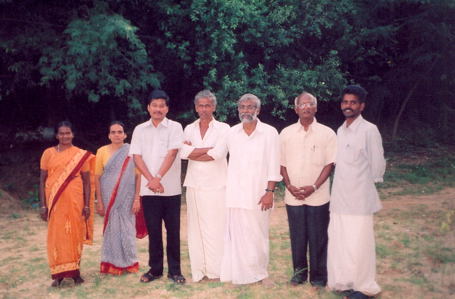
Impressed with the FAHC work at Pattenchery, my father-in-law gave us a green signal. More talks about what, when, and how. Things started to come together. During December 2007, ten needy children were selected from our school. Met with their parents and consent was taken. On January 26th 2008, on the Republic Day weekend, VKN, his wife, three children and FAHC team from Kerala visited Nandyala. Here is what happened next:
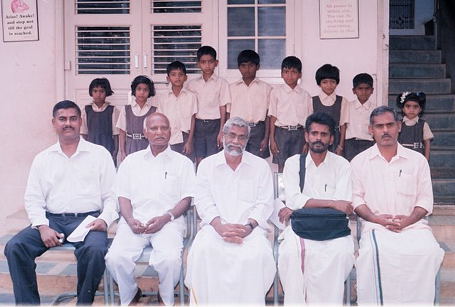
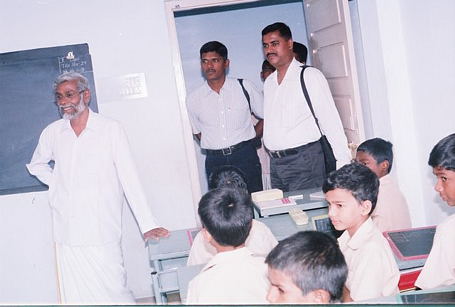
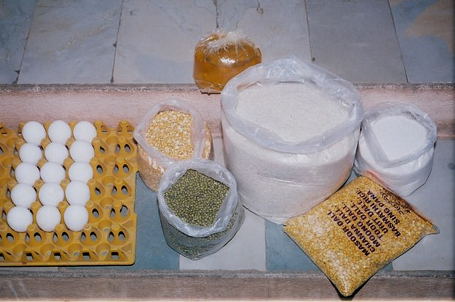








FAHC Nandyala unit is providing essential groceries and food grains every month, starting from January 2008 to a total of ten children. The children are also getting good education at our school via the scholarship program we sponsor. The plan is to support the children until they finish their high school education.
This was possible only because of community effort by the wonderful food bloggers and the food blog readers. We thank you all for your generous contributions and support shown. I also thank my family members for their unconditional and wholehearted support and efforts. We hope to do this on a larger scale next year.
Note:
The money raised through the fund-drive on Mahanandi went directly to the parent organization, FAHC. All the transactions and expenditures are properly accounted, monitored and audited by the trust board established by FAHC. Before starting the dedicated unit at Nandyala, the trust members had personally visited and met with the children and their families to identify the genuinely needy children. All the expenses, payments and distribution process are properly documented and transparently maintained. For further details, please contact VK Narayanan at FAHC.
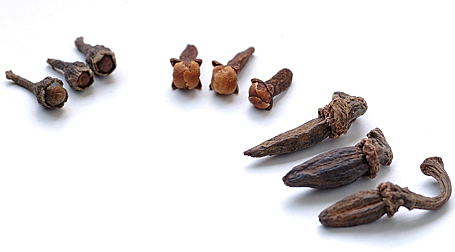
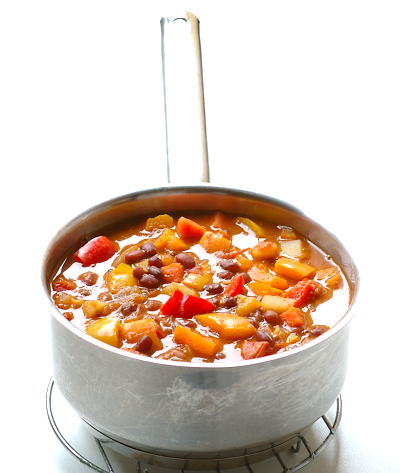
African food, at least here in the west, is usually restricted to East African staples like the delicious Ethiopian dosa, the Injera or entrees such as the equally delectable Moroccan chickpea stew (normally served over couscous) common to North Africa.
But what of the quintessentially South African Chakalaka?
As one examines the recipe, it’s not hard to imagine South African cooks venturing out into their vegetable garden one hot day, picking onions, red peppers, tomatoes and any other readily available seasonal produce. As the vegetables cooked, they probably craved some of the flavors they remember smelling as they walked down a street with Indian houses. Inspired, they might have thrown in a liberal dose of curry powder into the simmering vegetables in the pot. Since many variations also include tinned baked beans, hungry laborers might have adapted it as a quick and satisfying one-pot meal at the end of a hard day of slogging it in the gold mines.
With my well-equipped Indian kitchen, Chakalaka was a breeze to whip up. Indeed, the Indian influences are not surprising. Indians have been in South Africa longer than Caucasians have been in Canada! So at least for 7-8 generations. In fact, our beloved Mahatma Gandhi cut his revolutionary teeth in South Africa.
But back to Chakalaka (don’t you just love the sound of the name?)
While the jury is still out on whether Chakalaka is a chunky ketchup or a sauce or a cooked salsa (could be either); on whether it should be served as a side dish or a condiment (served as both) and if it should be eaten hot or cold (served either way), this spicy and always vegetarian concoction has now come to be identified as the definitive taste of South Africa. There’s even a restaurant in London named for this dish. Featuring a standard base of onions, tomatoes and peppers; this versatile dish is open to endless experimentation.
Other bloggers tell us that traditionally, Chakalaka is often served as a sauce with a maize porridge (Mielie Pap) that is eaten predominantly by the local black population. It’s also served with bread or the ragi-like Samp, made of maize. It can also be spotted as an accompaniment at South African barbecues called Braais (pronounced “bry”, rhyming with the word “cry”)
In the spirit of making a mean Chakalaka that is true to its African roots as well as its spirit of assimilation and innovation, my version is based on a number of recipes found online as well as one that was featured in the Toronto star.
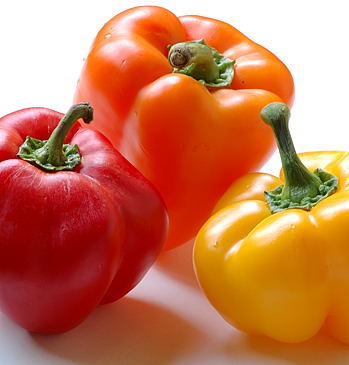
Recipe:
(Makes enough for approx 30 tablespoon servings)
2 tablespoons of sunflower oil
1 inch piece of ginger, peeled and finely diced
2 cloves of garlic, peeled and finely diced
4 fresh green chillies, slit
1 big red onion, finely chopped
A pound (4 to 6) juicy tomatoes, finely chopped
3 bell peppers, chopped into 1cm X 1cm pieces
2 carrots and 2 potatoes chopped into 1cm X 1cm pieces
Curry powder – 1 heaped tablespoon.
Red beans – one cup, pre-soaked and pressure-cooked to tender
Salt – one teaspoon, or to taste
Fresh coriander for garnish
In a saucepan, heat up the oil and saute ginger, garlic, chillies and onions to soft. Add the salt and curry powder. Add the tomatoes and cook till mushy and of sauce consistency. Add peppers, carrots and potatoes. Cook till they are of a desired softness. Add the red beans and cook for 5-10 minutes. Remove from heat and add coriander. Check seasoning levels and serve with rice or breads of your choice.
A small confession. After adding the beans, I tasted it and found the heat was a bit too much. So I caved and added a teaspoon of jaggery at the end. Unsuspecting victims, tasters of the dish said it took them to whole new levels of delayed heat which overwhelmed the palate after the initial deceptive sweetness. But they all agreed they couldn’t get enough of it!
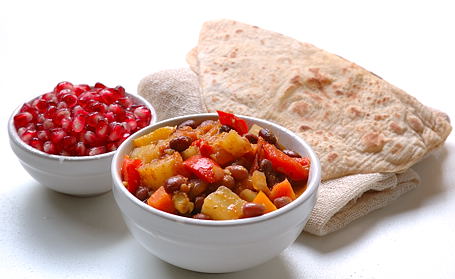
~ Article Contributed by Janani Srinivasan
Photos by Indira Singari.
Kitchen Notes:
Other vegetables can also be added to Chakalaka – cauliflower, zucchini, string beans etc
For curry powder – if you have access to it, I recommend the fiery Sri Lankan Niru brand powder so ubiquitous in Toronto. If not, any other store-bought or homemade will do. The South African recipes recommend a local brand called “leaf masala”.
To be true to the grassroots appeal of this dish, you could use a can of baked beans from the local supermarket. Vegetarians check labels to ensure it’s free of lard or any other animal ingredients. If you can soak your own from scratch, that’s even better.
More on Chakalaka : Chakalaka 101, and Culinary Musings from Cape Town
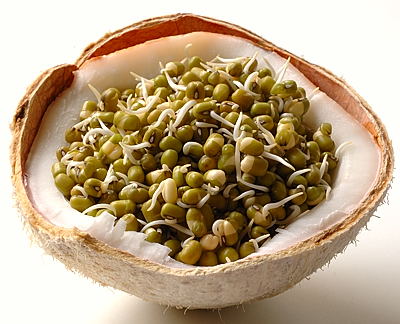
Mooga-Gaathi, a traditional Goan-Konkani recipe with sprouted moong beans and fresh coconut may sound like another unassuming moong dal preparation. But you would be delighted to find out the appetite-arousing attitude of this homey, gentle sounding dish. All thanks to spices – nutmeg, cloves, coriander and peppercorn.
The recipe is from my friend Veena Parrikar‘s kitchen. I made small changes here and there to the original to suit my taste. Easy to prepare, minimum work, no cutting or slicing things, and satisfying results. A perfect autumn recipe and a must try for sprouted moong bean fans. I totally recommend.
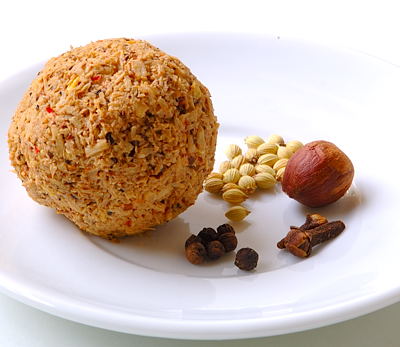
Recipe:
(for two, for two meals)
Sprouted moong(mung) beans – 4 cups
Fresh coconut gratings – 2 tablespoons
Spices:
Nutmeg – a small piece
Cloves – 3
Coriander seeds – 1 teaspoon
Black Peppercorn – ¼ teaspoon
Dried red chillies – 2
Tamarind pulp – 2 teaspoons
Turmeric – ¼ teaspoon
Salt – ½ teaspoon or to taste
For popu or tadka:
1 tablespoon ghee or oil
8 curry leaves
¼ teaspoon each – cumin, mustard seeds and asafoetida
1. Place a wide pot on stove-top and heat.
Add and dry-roast the nutmeg, cloves, coriander seeds, black pepper and dried red chillies to fragrance. Remove them to a mixer. Add fresh coconut and grind to smooth paste. For easy blending, you could also add about half cup water.
2. In the same pot, take sprouted moong beans. Add about 2 to 3 cups of water and stir in salt. Cover and cook. When moong beans reach required level of tenderness, add the ground-spice paste, tamarind and turmeric. (I also added a tablespoon of jaggery.) Mix well and simmer on medium heat.
3. While the moong is simmering, do the popu or tadka. In a small skillet, heat oil until a curry leaf tossed in it sizzles. Add and toast curry leaves to pale gold. Next goes the cumin, mustard seeds and asafoetida. Wait for the mustard seeds to splutter. And, immediately add the skillet contents to simmering moong dal. Mix, reduce heat and simmer for another five to ten minutes to blend the flavors.
Serve or spoon into a small bowl and enjoy with rice or chapatis.
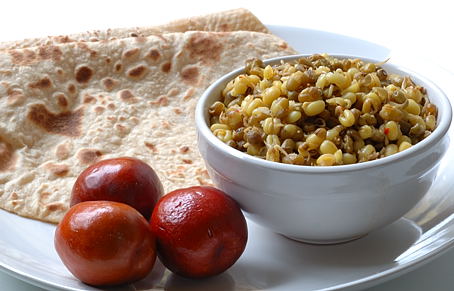
Notes:
The original recipe did not have cumin seeds in tadka/popu. They are not used in gaathi.
How to sprout Moong Beans: Soak moong beans in water overnight. Next morning, drain into a muslin covered colander. Cover the beans with cloth, and keep the colander in a warm area. Sprinke water occasionally to keep the cloth moist. Within a day, you start seeing the sprouts. Wait for next morning. There you go, you have your own homemade sprouts ready for Mooga-Gaathi.
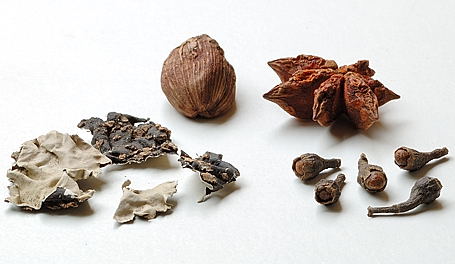
from Hindi/Marathi to Telugu and English:
Dagad Phool = Kallupachi (Black Stone Flower)
Kala Elachi = Nalla Elakulu (Black Cardamom)
Badal Phool = Anaspuvvu (Star Anise)
NaagaKeshar = Naaga Sagaralu
Vijay K Narayan of My Dhaba food blog is requesting us all to donate smiles through the Feed a Hungry Child (FAHC) fund-drive. FAHC operates on the principle that all children are entitled to a decent meal. Children who do not get proper meals are unjustly put in this condition. These children did not choose their parents nor are they responsible for their parents’ financial condition. FAHC addresses the ultimate holistic need, the hunger of each child it supports, and believes that illiteracy, malnutrition, and other concerns can only be addressed when hunger is appeased.
With the help of volunteers, FAHC has begun to supply feeding kits to 14 children and their families in Palakkad district of Kerala in India, since April 2007. Now FAHC needs our help. The fundraising goal is $ 3,360. I think we can do it easily. Please click the Chip In button at the top right of the site, and contribute whatever you can. If you require additional incentive to contribute, check out the contents of feeding kit and try to remain unmoved.

For additional information about FAHC and Donate Smiles Fund-drive:
Website: FAHC
Contact: info.fahc@gmail.com
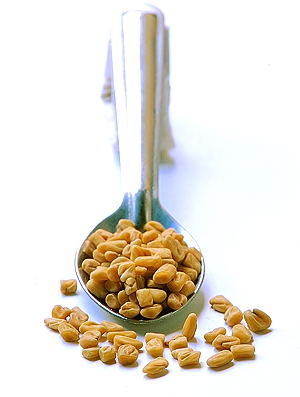
The one flavor category that is fading away from our meals today is the “bitter†flavor. The bitter taste category is considered to be one of the most healing and cleansing tastes by Ayurveda. Use of fenugreek seeds in traditional tadka is a good way to incorporate the bitter taste once in a while.
Fenugreek (Trigonella foenum-graecum) is a member of the pea family. Fenugreek plant is an annual with yellowish-white flowers and its pods contain 10-20 seeds. The common method of harvesting is to uproot the whole plant, allow them to dry in the Sun and then remove the seeds by threshing.
Whole fenugreek seeds have no aroma but once ground, they release flavor and sharp, spicy aroma. These seeds are very high in protein. 3.5 ounces (100 gms) of uncooked seeds supply 23 gms of protein. This is almost equivalent to the amount of protein found in a 3 -3.5 ounces serving of meat, fish or poultry.
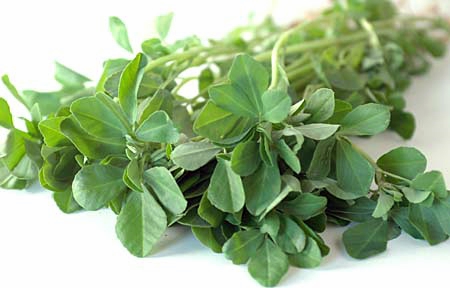
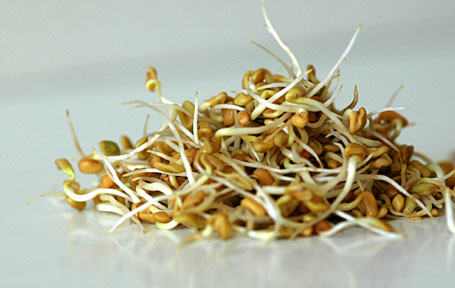
Fenugreek seed sprouts are used in salads. These sprouts are rich in iron and phosphorous. Juice from the sprouts is considered a cleanser of the kidneys and bladder.
In Maharashtra, we make an interesting pickle with methi sprouts, called Methi-Mirchi. This pickle stays good just for one to two days .
¼ cup fenugreek sprouts
1 Green Chilli – slit in middle and then cut into small pieces
2 tsp Mustard seeds
Pinch each – Asafoetida and turmeric
1 Lemon and salt to taste
Heat oil. Add mustards seeds, asafoetida, and turmeric. When mustard seeds start to pop, then add fenugreek sprouts and green Chilli. Mix well. Take off the heat. Add salt to taste and squeeze lemon juice. This pickle has a great combination of bitter, spicy and sour tastes.
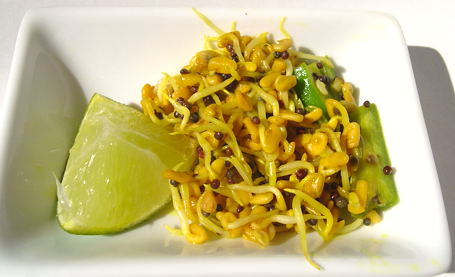
Fenugreek seeds are antiseptic and warming. It also has expectorant qualities and is used to ease coughs and sore throat. Fenugreek tea is used as a Blood builder and cleanser.
To make fenugreek tea – bruise 2 tablespoons of seeds. Add four cups of water and bring to a boil. Cover and simmer for ten minutes. Add honey or lemon to flavor.
One of the five spices in Panch phoran is fenugreek seed. They are also added in curry powder, sambar powder and essential picking spice. It’s a very common practice for most of us to add a few fenugreek seeds to tadka when making everyday dal.
Dal-Methi with fenugreek seeds is a common dal among us Maharashtrians. I make this dal at least 2-3 times a month and it’s a good way to introduce fenugreek seeds to kids.
To one cup toor dal, add two to three teaspoons of fenugreek seeds and two cups of water. Pressure-cook to soft. Heat oil. Add mustard seeds, turmeric, green chilli and asafoetida. Add the toor dal-methi mix. Cook for two minutes. Season with salt and cilantro. Serve with roti.
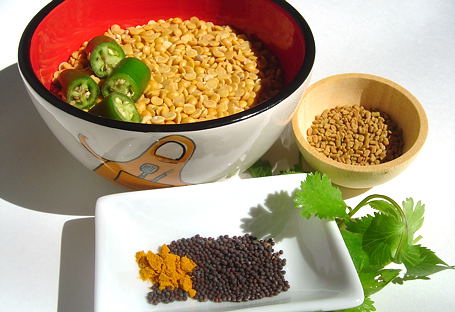
Ah! And how can we talk about fenugreek seeds and not talk about Fenugreek Seed Laddu (Methi Laddu)? Considered to be good for health and winter warmers, methi laddus are consumed in winter season to ward off cold, cough and fever. Here is a simple methi laddu recipe from Bawarchi.
It’s also a common practice in many parts of India to give methi laddu to the lactating mothers. I had these laddus after my daughters birth and many who have tasted these laddus would agree with me that they do not bring out the “hmm…” feeling. But Lakshmi Ammal of “Cook Food and Serve Love” has come up with an interesting Sweet Fenugreek Pongal. I wish I knew about this pongal eight years back.:) (Since fenugreek seeds are considered a uterine stimulant, they are avoided during pregnancy.)
Packed with protein and punch, and with so many benefits, it’s no wonder that the tiny fenugreek seeds have earned a very respectable place in our Indian spice box.
~ Guest Article by Anjali Damerla of Supreme Spice
If you have questions about fenugreek seeds, please post them in comments section. Anjali would be glad to answer them for you. Thanks.
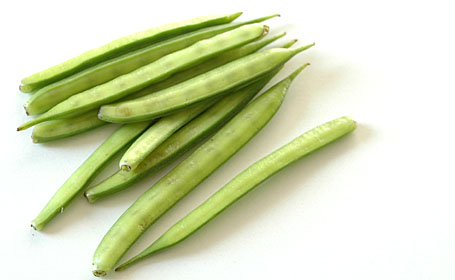
Gawar beans seem to be purely Indian vegetables. I came to this conclusion only because I have never seen these beans in any other grocery places. Not Chinese, nor Thai, with whom we share many vegetables. Even though they are very common at Indian ritu bazaars (farmer markets), they are a rare find at Indian grocery shops here in US. I happen to like gawar beans very much. So whenever I see them, I buy a whole bunch, for at least two days’ curry-worthy. For the first-timers, the beans are easy to identify. They have a distinct flat appearance. Pale green and thin skinned ones with undeveloped seeds are best for cooking. Gawar beans are crunchier than green beans and have a slightly tougher texture, and can take a little more cooking without getting mushy. They are great simply blanched, stir-fried, or cooked with flavorful sauces, and could be served hot or cold.
For today’s meal, I seasoned the blanched gawar beans with fresh coconut and ripe red chillies. And added goda masala at the end. One tasty kura was ready for chapatis.
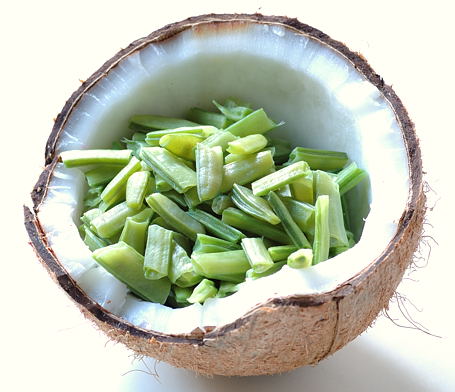
Recipe:
Gawar beans – half pound, about two cups of cut beans
Red onion, finely sliced – half cup
Ripe red chillies, finely sliced – a tablespoon
Fresh coconut, grated – two tablespoons
Goda masala – one tablespoon
Turmeric and salt – ¼ teaspoon each, or to taste
Gawar beans:
String the beans, and pinch off the ends. Wash and cut or snap to one inch length pieces. Add them to boiling water. Cook for a minute or two and drain.
Seasoning:
In a wide skillet, heat a teaspoon of peanut oil.
Add a sprig of curry leaves and pinch each – cumin and mustard seeds.
When seeds start to pop, add onions and ripe red chillies. Saute to crisp.
Add the blanched gawar beans. Stir in coconut, goda masala, turmeric and salt.
Mix and then cover the skillet. Cook for about five minutes.
Serve hot. Gawar beans kura tastes superb with chapatis / rice and dal.
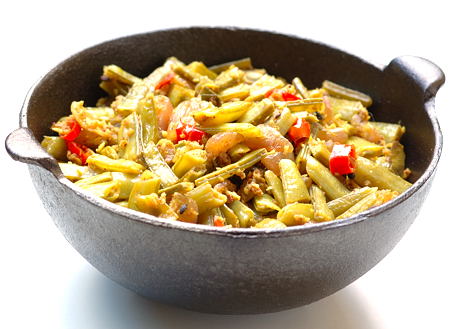
notes:
Gawar beans are available, fresh and frozen at local Indian grocery shops, here in US.
From Telugu to English, Kura=Curry
These habit-forming sweet banana biscuits are easy to like. I surely can say that judging from the speed at which they get gobbled up every time I make them.
The recipe is based on traditional Mangalore buns. Honeyed fragrance and creamy sweetness of banana could be felt and tasted, but it would not over-power the taste buds. A good and fun snack.
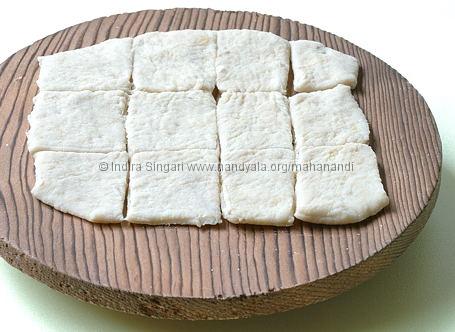
Recipe:
(for 20 to 25 small biscuits)
1 cup maida (or all-purpose flour)
1 ripe banana
2 tablespoons sugar
1 tablespoon melted ghee
¼ teaspoon cardamom powder
Peanut oil to deep-fry
Blend or mash banana and sugar to smooth consistency. Add to flour.
Stir in cardamom and ghee. Mix to prepare tight dough. Rest for an hour.
Divide the dough to lemon sized rounds and roll out each round to a thin circle.
Cut to squares like shown in the image and deep-fry to gold.
Regular chapati style pressing yields soft and chewy biscuits. For crispy and crunchy biscuits, press out the dough to thin.
If you’d like to take it up a notch, dip the fried biscuits in sugar syrup like we do in jilebi or roll them in sugar like beignets.
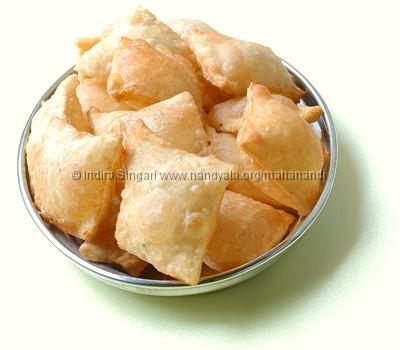
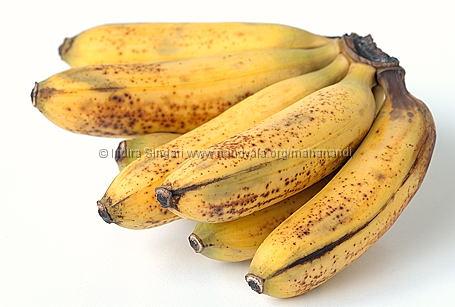
Weekend Reading:
Blogger to WordPress ~ The Move
WordPress 2.3 and Movable Type 4 ~ The Comment Exchange
The Saga of a Lemon Rasam
Mavalli Tiffin Room ~ MTR
The taro root I planted in May has now grown to a decorative type of plant with beautiful looking leaves. Growing taro at home turned out to be an easy process. I have planted small variety taro similar to what we see around Nandyala region, India (which is different from the elephant or giant type taro). I placed a healthy looking taro root in a container and loosely covered it with soil. Kept the container in patio where the sun shines and watered it daily. In just two months, around July, a young shoot appeared. Now the plant has six healthy looking leaves and thriving.
My taro growing fancy is mainly for taro leaves. The leaves are perfectly edible plus they are nutritious. We use only young leaves for cooking. With unique flavor and great taste, young taro leaves are easily likable. Back at home in Nandyala, my mother prepares two recipes with young taro leaves – a spinach style curry, where the blanched and finely chopped leaves are sautéed with onions and second is a flavorful dal where the taro leaves are steamed with toor dal. Dal has been invariably my favorite taro leaf preparation and is our meal today.
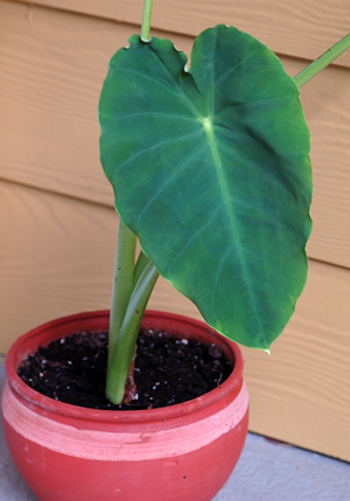
Recipe:
Toor dal – 1 cup
Young taro leaves – 4 (about the size of ping-pong paddle), finely chopped
1 small onion and 6 green chillies – coarsely chopped
Tamarind pod – about the size of a small finger, seeds removed
¼ teaspoon turmeric
Take them all in a pressure cooker. Add about two cups of water and cook until the dal reaches fall-apart stage. Once the valve pressure is released, remove the lid and add half teaspoon of salt to the cooked contents. Mix, and gently mash the dal to soft consistency with wood masher or immersion blender. Set aside.
Now do the tadka: In a small pot, heat a tablespoon of oil or ghee over a medium-hot burner. Add a teaspoon of minced garlic, a sprig of fresh curry leaves. Toast them to pale brown. Then add a pinch each – cumin, mustard seeds and asafoetida. Stir and wait for the mustard seeds to pop. This process is called tadka.
Add the mashed dal to the tadka contents and mix thoroughly. Serve the dal over rice or chapati with a teaspoon of ghee drizzled in for a scrumptious meal.
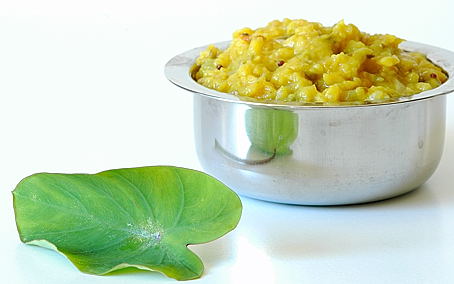
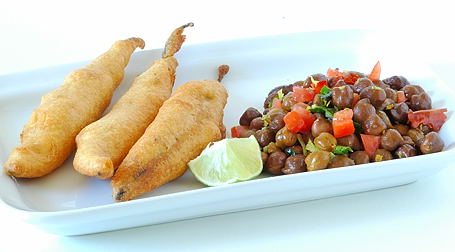
Recipe Source: Amma, Nandyala